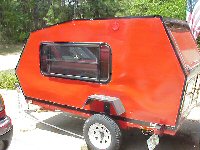Tom&Shelly wrote:saltydawg wrote:I would bet the "standard" teardrop battery is a 100 amp hour or smaller lead acid either agm or fla. So even at the recommended charge rate of 10 amps, can you charge thru the 7 pin, yes you can. But your looking at a 5 hour drive to charge from 50%. Then you do run into issues with voltage drop ( minimal ), and the alt in the car is looking at the starter battery, and the trailer battery as a load on it not something it sees as needing a charge.
As it happens, that describes our system as I designed it (with AGM battery), and meets our specs. Our plan is to do lots of driving (in parts of the continent that don't always have lots of sunlight), so we'll likely see 5-8 hour drives every few days. I don't think we'll often get the battery down 50% between the drives though.
Worse, for those who worry these sorts of things: Our PD 4045 (for when we park at camp sites with shore power, or near certain dams in Canada, where I hear they give their product away free) has a smart charger, but no way to switch between FLA and AGM.

Oh, and then, when the teardrop is "in hanger", it'll be in one without AC power, so that's when we'll use a solar panel on the roof, with PWM controller.
As a retired Electrical engineer, I looked on this forum and others, considered the pros and cons (and some of the less than accurate material presented by certain nameless "cons"), and decided the KISS principle does indeed make sense.
We're just starting to use our teardrop this Spring, so, I'll let you all know in a few years if our battery cries uncle. Perhaps I'm making a mistake, and abusing an innocent battery. But it appears DC/DC chargers cost as least as much as the difference between the FLA and AGM batteries.
Scott, I do like the idea of feeding the TV power through an MPPT controller. Thank you. If the system turns out to need a redesign, that's one to consider. Or maybe, by then, we'll be ready to put a panel on the teardrop roof and feed it to the PWM controller. We'll be older then, and perhaps ready to stick to the sunny west.
So John (who started this thread--not the other one), the only advice I have as you design your system is to consider how you plan to camp, make a rough inventory of the electrical devices you want and how much power you think you'll use, and your budget. There's more than one way to design these systems.
Tom



